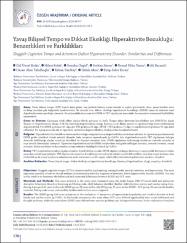Yavaş bilişsel tempo ve dikkat eksikliği hiperaktivite bozukluğu: Benzerlikleri ve farklılıkları

Göster/
Erişim
info:eu-repo/semantics/openAccessTarih
2020Yazar
Bolat, Gül ÜnselBolat, Hilmi
Özgül, Semiha
Süren, Serkan
Yazıcı, Kemal Utku
Bacanlı, Ali
Tahıllıoğlu, Hasan Akın
Parıltay, Erhan
Akın, Haluk
Ercan, Eyüp Sabri
Üst veri
Tüm öğe kaydını gösterÖzet
Amaç: Yavaş bilişsel tempo (YBT) hayale dalıp gitme, boş gözlerle bakma, kafası karışık ve şaşkın görünümde olma, yavaş hareket etme
ve kolay yorulma gibi bulgularla karakterizedir. En önemli soru, dikkat eksikliği hiperaktivite bozukluğu (DEHB) tanısı ile ilişkisini nasıl
değerlendirmemiz gerektiği olmuştur. Bu çalışmadaki amacımız ise DEHB ve YBT olgularının arasındaki davranışsal ve emosyonel farklılıkları
saptamaktır.
Gereç ve Yöntem: Çalışmaya dahil edilen olgular klinik görüşme ve Atilla Turgay yıkıcı davranım bozuklukları için DSM-IV’ye dayalı
Tarama ve Değerlendirme ölçeği, 4-18 Yaş Davranış Değerlendirme ölçeği, Barkley çocuk dikkat anketi ve öğretmen bilgi formu kullanılarak
değerlendirildi. Pür DEHB grubuna 145 olgu, pür YBT grubuna 23 olgu, DEHB + YBT grubuna 71 olgu ve sağlıklı kontrol grubuna 92 olgu dahil
edilmiştir. Bu 4 grup arasında aile ve öğretmen tarafından değerlendirilmiş ölçek puanları karşılaştırılmıştır.
Bulgular: Hiperaktivite/dürtüsellik ve davranım bozukluğu semptomlarının değerlendirilmesinde hem aile hem de öğretmen puanlamasında
DEHB grubu istatiksel olarak anlamlı düzeyde fazla semptom taşımaktaydı (p<0,001). Aile değerlendirmesinde YBT olgularının belirgin
derecede farklılaştığı alanlar sosyal içe dönüklük ve düşünce sorunları iken, DEHB olgularının farklılaştığı alanlar ise somatik sorunlar ve
suça yönelik davranışlar olmuştur. Öğretmen değerlendirmesinde DEHB semptomları varlığında saldırgan davranış, somatik sorunlar, sosyal
sorunlar, dikkat sorunları ve dışa yönelim semptomlarının fazlalığı belirlendi (p<0,001).
Sonuç: YBT semptomlarına sahip olgular sosyal içe dönüklük konusunda, DEHB olguları saldırgan davranış ve suça yönelik davranış sorunları
açısından zorluk yaşamaktadır. YBT olgularının sosyal içe dönüklük göstermelerinin sebebi sosyal fobik özelikler mi yoksa sosyal iletişime olan
isteksizlik ya da sosyal ipuçlarını anlayamama mıdır sorusunun cevabı uygun tedavi edici yöntemlerin gelişmesine yardımcı olacaktır. Objectives: Sluggish cognitive tempo (SCT) is characterized by daydreaming, staring blankly, mental confusion, and hypoactivity. The most important question is how we should evaluate its relationship with the diagnosis of attention deficit hyperactivity disorder (ADHD). Our aim in this study is to determine the behavioral and emotional differences between ADHD and SCT cases.Materials and Methods: The cases included in the study were evaluated using the Atilla Turgay DSM‐IV‐based child and adolescent disruptive behavioral disorders Screening and Rating scale, child behavior checklist, Barkley child attention survey and teacher rating form. Among 4 groups (145 cases in the only ADHD group, 23 cases in the only SCT gorup, 71 cases in the ADHD + SCT group, 92 cases in the healthy controls), Rating scale scores evaluated by families and teachers were compared.Results: The ADHD group had more symptoms in the evaluation of symptoms of hyperactivity/impulsivity and conduct disorder in both family and teacher scores (p<0.001). In the family assessment, the areas where SCT cases differed significantly were social withdrawal and thought problems, while the areas where ADHD cases differed were somatic problems and delinquent behaviors. In the evaluation of teachers report, the presence of ADHD symptoms was associated with aggressive behavior, somatic problems, social problems, attention problems, and externalizing symptoms were determined.Conclusion: Patients with the symptoms of SCT have difficulties with socially withdrawn and ADHD cases have difficulties in terms of aggression and delinquent behavior problems. The answer to the question of whether or not the reason that the SCT cases show social withdrawal is social phobic features, or reluctance to social communication, or failure to understand social cues will help develop appropriate therapeutic methods.
Kaynak
Çocuk ve Gençlik Ruh Sağlığı DergisiCilt
27Sayı
3Bağlantı
https://doi.org//10.4274/tjcamh.galenos.2020.65707https://hdl.handle.net/20.500.12462/11991

















